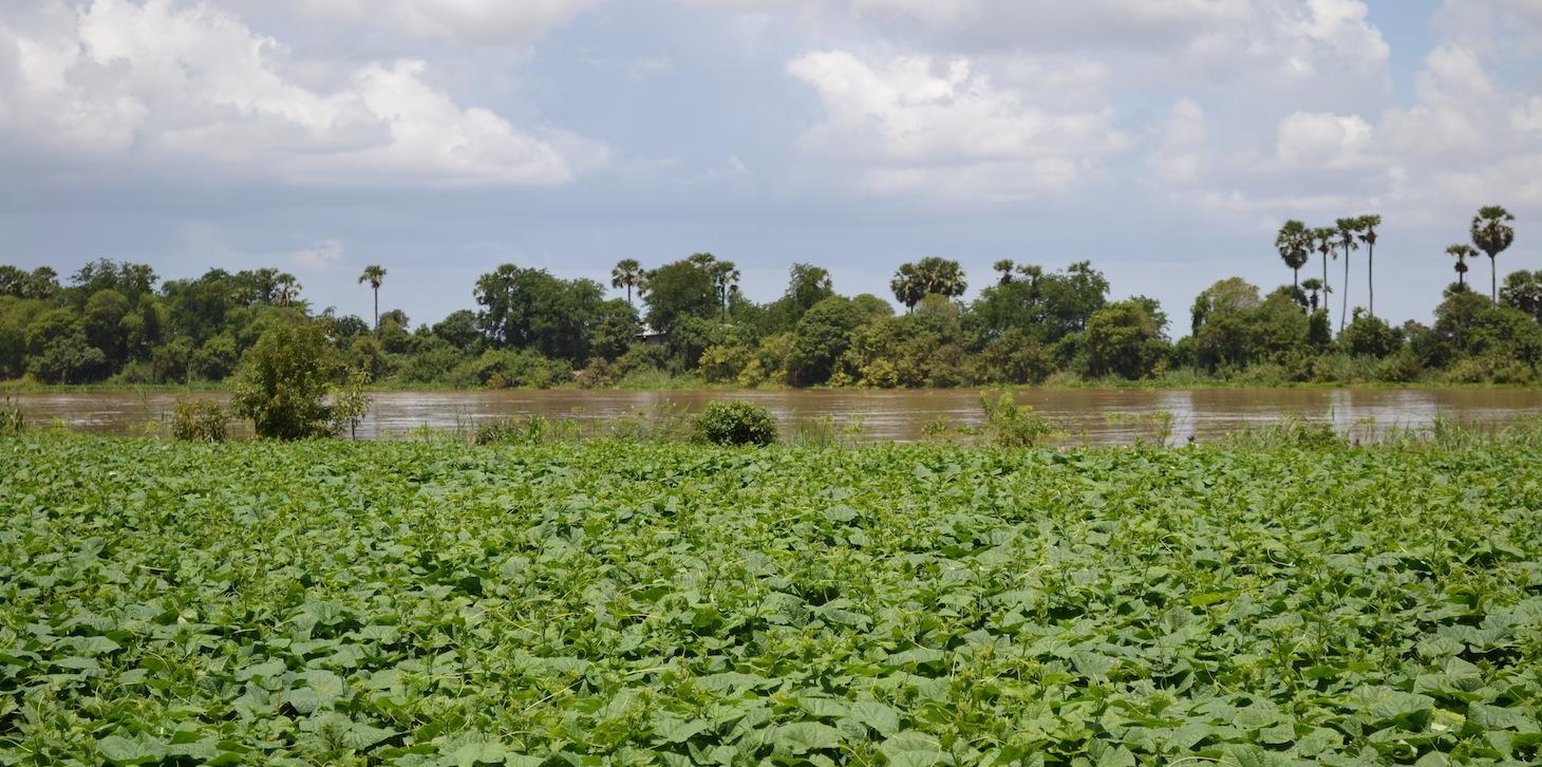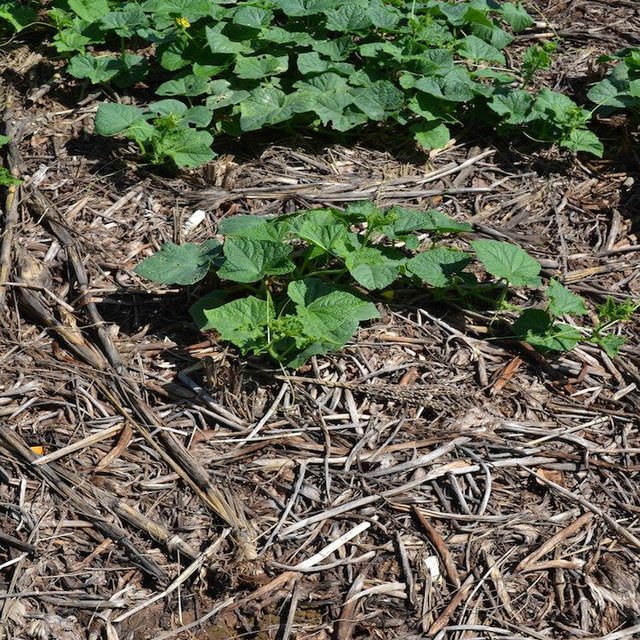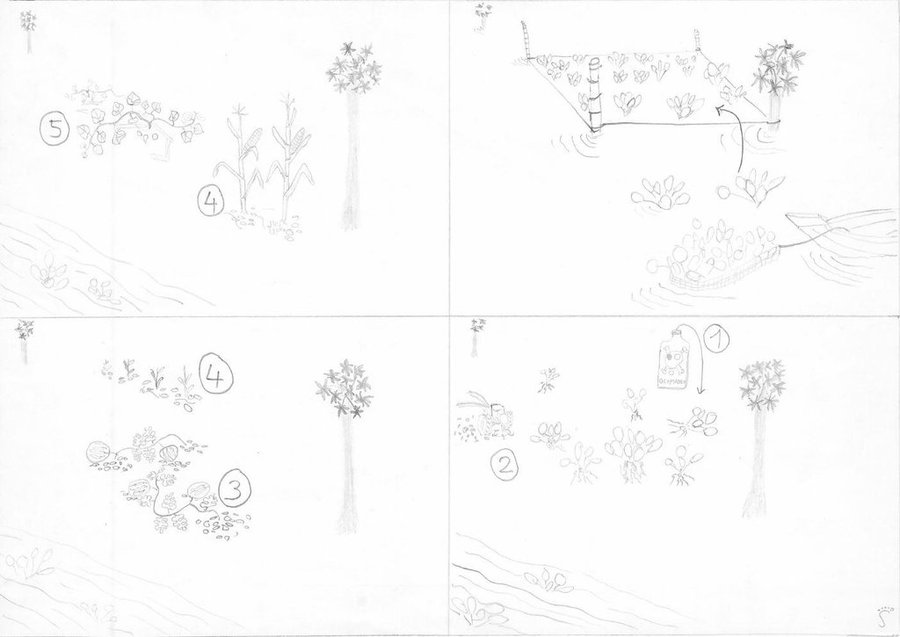



This mulching technique is used at the riverside of the Tonle Sap River. The area is flooded during the late rainy season (September to November), and alluvial mud is deposed on the fields, which enhances the soil fertility. The deposition of sediments depends on the extent of the yearly flood, and is threatened by the construction of hydropower dams on the upper Mekong River (Thomas et al. 2012:49), as well as climate change (floods tend to be smaller or more extreme). During the dry season (approximately from January to June, depending on precipitation patterns) the land dries and due to high temperatures and very low precipitations, crops can be harmed.
At first, the farmer gathers the water hyacinth with his boat during the wet season. He surrounds them with a net and pulls them to his fields, where he prepares fences with bamboo poles and iron wires. He fills the fenced area with the water hyacinth. Once the water recedes, he sprays glyphosate on the water hyacinths and chops them by using a hand tractor. He plants his first crop, watermelon, as soon as the soil is dry enough (start of dry season). The crop residues of the watermelon are left on the fields, and he can plant a crop of corn and a crop of cucumber before the next flood enters.
The analyzed area is flat (slope < 2%), tropic (dry and wet season), and the soils are mostly loamy. The groundwater table is rather high with 1-2 m during the dry season (November to May). The area is flooded during and after the wet season (August-September to November). The floods bring sludge and thus nutrients to the fields.
Due to climate change, the rainfalls are more erratic, temperatures rise and droughts are more recurrent. Chili is the cash crop predominantly grown in the flooded area, with floating rice as second crop.
Agricultural activity in this region is confronted with high migration rates (garment industry, cities, or other countries). This is detrimental for the farmers, since there is less labour force available. Also, the presented technology requires a rather high initial investment (especially when a tractor is bought) and an increase of physically strenuous labour. Therefore, the interviewed land user stated that most farmers are reluctant to do high investments on their farm. This is aggravated due to the fact that taking up credits might increase the dependency of the farmer.
地点: Kampong Os, Kampong Chhnang, 柬埔寨
分析的技术场所数量:
技术传播: 均匀地分布在一个区域 (0.02 km²)
在永久保护区?:
实施日期: 不到10年前(最近)
介绍类型






| 对投入进行具体说明 | 单位 | 数量 | 单位成本 (不适用) | 每项投入的总成本 (不适用) | 土地使用者承担的成本% |
| 设备 | |||||
| tools | ha | 1.0 | 130.0 | 130.0 | 100.0 |
| boat | ha | 1.0 | 1000.0 | 1000.0 | 100.0 |
| hand tractor | ha | 1.0 | 1500.0 | 1500.0 | 100.0 |
| 肥料和杀菌剂 | |||||
| biocides | ha | 1.0 | 4.5 | 4.5 | 100.0 |
| 施工材料 | |||||
| wires and bamboo poles | ha | 1.0 | 30.0 | 30.0 | 100.0 |
| 技术建立所需总成本 | 2'664.5 | ||||
| 技术建立总成本,美元 | 2'664.5 | ||||
| 对投入进行具体说明 | 单位 | 数量 | 单位成本 (不适用) | 每项投入的总成本 (不适用) | 土地使用者承担的成本% |
| 劳动力 | |||||
| labour | ha | 1.0 | 35.0 | 35.0 | 100.0 |
| 设备 | |||||
| machine use | ha | 1.0 | 10.0 | 10.0 | 100.0 |
| 技术维护所需总成本 | 45.0 | ||||
| 技术维护总成本,美元 | 45.0 | ||||
SLM之前的数量: 50
SLM之后的数量: 100
According to the farmer the yield doubled.
Grows other cash crops than the other farmers in the area.
However, there is less irrigation work needed.
Herbicide is used in the river.
Problems with insects
Herbicide goes into the river